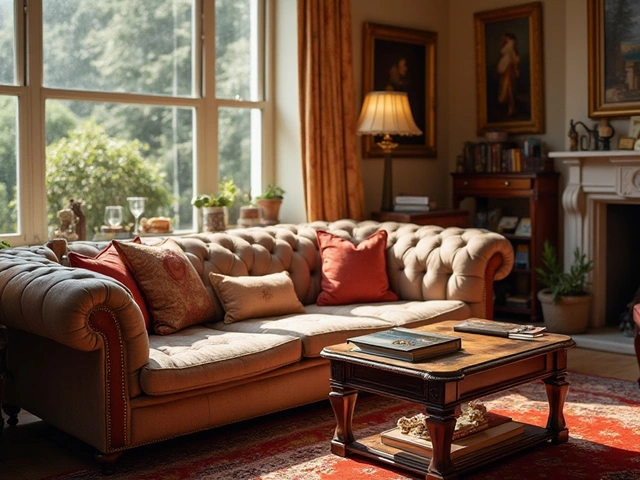We use mirrors every day—maybe more than we realize. But did you ever wonder if people in Bible times worried about their hair, their faces, or what mirrors could teach them? Mirrors might feel modern, but they've actually been around for thousands of years, and the Bible has a few things to say about them—some pretty surprising.
The way people used and understood mirrors back then was different from what we do now. Mirrors weren’t really about perfect selfies or having a spotless reflection. In the ancient world, mirrors were simple, made from polished metal, and owned by only the lucky few. They give us a glimpse into how people saw themselves, both outside and in.
But it’s not just about the object—mirrors in the Bible pop up in stories, poetry, and lessons that still make sense if you pause and think. Some verses link mirrors to deeper questions about who we are and what we show the world. So if you’ve been curious about whether the Bible has anything to say about your bathroom mirror or the bigger meaning of reflection, you’re in for some interesting finds.
- Mirrors in Ancient Bible Times
- What the Bible Literally Says About Mirrors
- Mirrors as Metaphors in Scripture
- Famous Bible Verses About Mirrors
- Lessons About Self-Reflection
- Practical Takeaways for Today
Mirrors in Ancient Bible Times
When you think of mirrors from Bible times, forget about today’s glass ones for a second. Back then, a mirror was usually just a piece of polished bronze, copper, or sometimes silver. These metal plates were shaped by hand, and folks would have to polish them a lot just to keep any kind of clear reflection.
Most historians say these mirrors popped up in the ancient Middle East around 2000 B.C.E. That means by the time stories from the Bible were getting written down, people already knew what a mirror was—even if it looked nothing like the ones we use now.
Mirrors were kind of a luxury item. Ordinary families often shared one, and you’d definitely notice if you saw your face in one—the reflection was way blurrier than what we’re all used to now. Glass mirrors actually didn’t hit the scene until Roman times, which is much later than the Old Testament days.
Here’s a quick look at how ancient mirrors compare to what we’re used to:
| Type | Material | Clarity |
|---|---|---|
| Ancient Mirror | Polished bronze, copper, or silver | Blurry, uneven |
| Modern Mirror | Glass with silver backing | Crystal clear |
These old-school mirrors show up in the Bible mostly in passing. For example, women brought bronze mirrors as offerings for building the basin in the Tabernacle (Exodus 38:8). That’s one of the only times mirrors get called out specifically. So, they played their part in daily life, but mirrors weren’t everywhere, and people didn’t use them constantly like we do now. Sometimes that blurry reflection said more about what you couldn’t see than what you could.
What the Bible Literally Says About Mirrors
If you’ve ever skimmed the Bible looking for something about mirrors, you probably noticed they aren’t brought up a ton—but they’re still there. The word "mirror" shows up just a handful of times, and most of the mentions are about real, physical items, not just examples or metaphors. Back in those days, mirrors weren’t made of glass, but mostly from polished bronze or even silver. When you read the stories, knowing what these mirrors were like helps a lot.
The most direct shout-out is in Exodus 38:8. Here’s what happens: When making the Tabernacle (that’s like a super-important tent for worship), the craftsmen actually used mirrors donated by women to create the bronze washbasin. These mirrors belonged to women who served at the entrance of the tent. So, the Bible literally tells us: people had and used mirrors, and sometimes they ended up in temple construction projects!
The book of Job (Job 37:18) mentions the sky being as hard and shiny as a "cast mirror." That’s one more clue: mirrors were tough, glossy metal objects, not crystal clear like ours today. Then in the New Testament, 1 Corinthians 13:12 talks about seeing "as in a mirror, dimly," meaning that reflections back then really weren’t that sharp.
| Reference | Context | Type of Mirror |
|---|---|---|
| Exodus 38:8 | Women’s mirrors used to make the washbasin for the Tabernacle | Polished bronze |
| Job 37:18 | The sky compared to a cast mirror | Cast metal |
| 1 Corinthians 13:12 | Seeing a reflection poorly, "dimly" | Ancient metal mirror |
So, the Bible shows that mirrors existed, they were made of metal, and they worked—just not as clearly as what we’re used to. If you’re using the Bible to track when everyday objects popped up, mirrors have their own spot in the story.
Mirrors as Metaphors in Scripture
Here’s where it gets interesting: in the Bible, mirrors are more than tools to check your teeth or hair. Writers used them as metaphors for what’s going on inside us. One of the most famous spots is in the New Testament. In James 1:23-24, there’s this line about someone who listens to God’s word but doesn’t act on it. It compares that person to someone who looks at their face in a mirror, then immediately forgets what they look like. It’s a vivid image, almost like taking a quick peek and moving on with your life, lessons forgotten.
Back when Paul was writing to the Corinthians (1 Corinthians 13:12), he talked about how we only see a “dim reflection” in a mirror, hinting that our understanding of spiritual things isn’t crystal clear yet. For them, those old metal mirrors gave blurry images—nothing like the glass ones we have now. It’s pretty much Paul’s way of saying, “We don’t see the full picture yet.”
Think about it: if a mirror only gives a rough idea of what you look like, it’s easy to fool yourself or ignore stuff you’d rather not see. The Bible uses this idea a lot to encourage honest self-reflection and real change instead of just acting like everything’s fine on the surface.
Here’s a quick look at two big Bible passages on this:
- James 1:23-24: It compares ignoring God’s teachings to forgetting your face in the mirror.
- 1 Corinthians 13:12: We only see part of the truth now, a fuzzy reflection, but one day things will be clearer.
Both of these drive home the point: don’t just notice what’s in the mirror, actually do something with what you see—inside and out. The ancient meaning still hits home in the age of selfies.

Famous Bible Verses About Mirrors
If you look up the word “mirrors” in the Bible, you won’t find a ton of verses. But the ones that do mention mirrors really stick, because they’re not just talking about glass and metal—they’re about looking deeper.
Probably the most quoted verse is James 1:23-24. It says, “Anyone who listens to the word but does not do what it says is like someone who looks at his face in a mirror and, after looking at himself, goes away and immediately forgets what he looks like.” This isn’t just about forgetting your hair in the morning. It’s a warning to not just skim the message and move on—if you’re hearing God’s wisdom, don’t tune it out. Use it. Live it.
Another one pops up in 1 Corinthians 13:12, which says, “For now we see only a reflection as in a mirror; then we shall see face to face.” Paul was talking to people who used metal mirrors that gave fuzzy, blurry reflections, so his point hit home. He’s explaining that right now, we don’t see the full picture. There’s stuff we just don’t get yet. The best part? He’s saying we will, one day, get perfect clarity.
Here’s a quick look at the key Bible verses related to mirrors, what they say, and what’s going on:
| Verse | What it Says | Main Idea |
|---|---|---|
| James 1:23-24 | Looking at yourself in a mirror but then forgetting right away | Don’t just listen, actually put things into action |
| 1 Corinthians 13:12 | Seeing a fuzzy reflection now, perfect clarity later | Our current understanding is limited, but it can get clearer |
| Exodus 38:8 | The women donated their bronze mirrors for making the washbasin at the Tabernacle | Mirrors were valuable, even used in worship |
So, even though mirrors were rare and not super clear, these verses use them as examples everyone could grab onto. Maybe not for checking eyeliner, but for checking what you’re actually doing with your life.
Lessons About Self-Reflection
When you spot a mirror in the Bible, it’s not just about how people looked—it's about what’s under the surface. The writers used mirrors as reminders to check up on ourselves, not just our faces, but our choices, too. James 1:23-25 is maybe the best example. It talks about someone hearing God’s word but not doing it: he’s like a guy who spots himself in a mirror, walks away, and forgets what he looks like. Basically, don’t just glance—take it in and let it change your actions.
This comes up again and again. In 2 Corinthians 3:18, Paul mentions that with God, it's like we use a mirror that isn’t foggy anymore. The idea is to actually see yourself clearly, flaws and all, and decide to do better. Real self-reflection comes from facing the truth, not just what’s easy or fun to see. The Bible pushes for honest, regular check-ins—sort of the original version of looking in the mirror and asking yourself, “Is this really how I want to be?”
Here’s a way to use this old wisdom right now:
- Pace yourself: Don’t just ‘check the box’—slow down and really notice your habits, like you’d check your reflection for spinach in your teeth.
- Ask tougher questions: Not just "Did I do good?" but "Why did I react that way?" or "Do I like this in myself?"
- Keep it honest: A dirty mirror doesn’t help anyone. Check in with people you trust or write things down so you don’t gloss over the hard stuff.
- Act on what you see: If you spot something about yourself you want to change, do something. Don’t be that guy James described who just shrugs and moves on.
Ancient Bible wisdom still lines up with regular life today. Real reflection—whether in glass or inside your head—should get you thinking, and hopefully, growing. That simple, daily glance in the mirror could be your chance to hit pause and get real, just like people did thousands of years ago.
Practical Takeaways for Today
If you’re wondering how ancient mirrors and old Bible lessons matter today, you’re not alone. Here’s the thing: even though our mirrors are high-def now, the way we use them is not so different from centuries ago. The Bible treated mirrors as more than just objects. They were a way to remind people to check what was inside, not just outside.
Let’s get hands-on. When you glance in your mirror every morning, you make split-second judgments. Some are about your looks, but many are about confidence, moods, and even how you feel about where you are in life. The Bible hints at the idea that it’s easy to fix up the outside but way harder to check your heart or your attitude. James 1:23-24 famously compares hearing the word but doing nothing with looking in a mirror and instantly forgetting what you look like. It’s more about action than appearance.
Here’s how you can turn these ancient ideas into practical steps:
- Pause for a second when you’re in front of the mirror. Ask yourself: “What do I see that isn’t physical?” If you’re annoyed, sad, tired—acknowledging it is the first step.
- If you want to use your daily mirror time to do more than just fix your hair, set a positive habit. Maybe it’s a quick pep talk. Or quietly thinking, “What’s one thing I want to do better today?”
- Use sticky notes on the mirror with Bible reminders or short motivational quotes. It’s a simple trick, but it really works to keep big ideas top of mind.
- Remember, none of us see ourselves perfectly. In Bible times, metal mirrors gave a blurry picture. Today, everyone still has blind spots—so stay curious about what you might be missing about yourself.
If you like numbers, here’s a quick comparison of ancient and modern mirrors so you get the practical difference:
| Time Period | Material | Image Quality |
|---|---|---|
| Biblical Era | Polished Bronze | Dim, blurry |
| Today | Glass with Metal Coating | Sharp, clear |
Bottom line—when you see your reflection, use your mirror time for more than grooming. Throw in some honest self-reflection and maybe even a second of gratitude. That shift could change how you walk out the door, just as much as fixing your hair or your collar.







